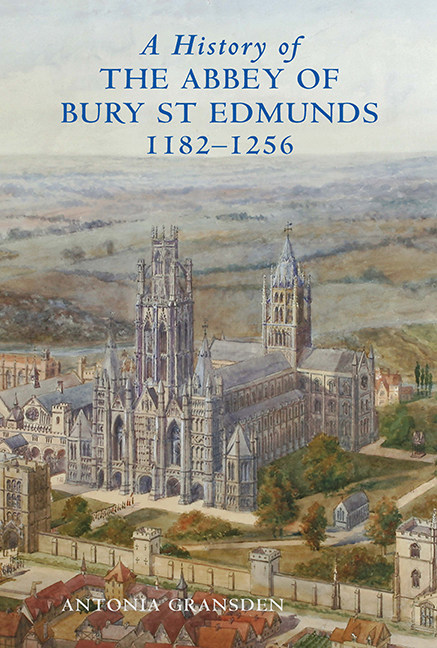Book contents
- Frontmatter
- Dedication
- Contents
- List of plates
- List of figures
- Preface
- Editorial Note
- Epigraph
- Acknowledgements
- Maps and plans (figures 1–9)
- Part I Samson of Tottington, Abbot 1182–1211
- 1 Samson's biographer, Jocelin of Brackland (de Brakelond), and his work
- 2 Samson's early life and career
- 3 Samson's election to the abbacy
- 4 The early years of Samson's abbacy and reform of estate management
- 5 Conflict with the convent
- 6 Relations with the town of Bury St Edmunds
- 7 Samson and secular law
- 8 Samson and the knights of St Edmund
- 9 Relations with the Angevin kings
- 10 Samson and the papacy
- 11 Samson as a builder
- 12 Religious and intellectual life under Samson
- 13 Samson's death and burial
- PART II The Abbey 1212–1256
- APPENDICES
8 - Samson and the knights of St Edmund
from Part I - Samson of Tottington, Abbot 1182–1211
Published online by Cambridge University Press: 29 April 2017
- Frontmatter
- Dedication
- Contents
- List of plates
- List of figures
- Preface
- Editorial Note
- Epigraph
- Acknowledgements
- Maps and plans (figures 1–9)
- Part I Samson of Tottington, Abbot 1182–1211
- 1 Samson's biographer, Jocelin of Brackland (de Brakelond), and his work
- 2 Samson's early life and career
- 3 Samson's election to the abbacy
- 4 The early years of Samson's abbacy and reform of estate management
- 5 Conflict with the convent
- 6 Relations with the town of Bury St Edmunds
- 7 Samson and secular law
- 8 Samson and the knights of St Edmund
- 9 Relations with the Angevin kings
- 10 Samson and the papacy
- 11 Samson as a builder
- 12 Religious and intellectual life under Samson
- 13 Samson's death and burial
- PART II The Abbey 1212–1256
- APPENDICES
Summary
One of Samson's problems was his relationship with the abbey's military tenants. He had to ensure that they fulfilled their obligations to him and to the king, and that their rights were protected against royal encroachment. The abbot of St Edmunds owed the service of forty knights. But he, like other tenants-in-chief, had enfeoffed knights in excess of his quota, in his case twelve extra. The situation is made clear by the list of knights’ fees returned by the abbey to the Exchequer in 1166. The return was in response to the questionnaire sent by Henry II to his tenants-in-chief. He demanded to know: what feudal service each owed and the number of sub-tenants each had enfeoffed both before 1135 (the ‘old enfeoffment’) and after 1135 (the ‘new enfeoffment’); and the names of the knights. The list for St Edmunds names thirty-eight knights of the old enfeoffment and one knight of the new enfeoffment (which shows that subinfeudation had taken place early on St Edmunds’ estates). The list concludes that though the abbey's service was for forty knights, fifty-two and three quarters knights’ fees had been created. It adds that Hugh Bigod (earl of Norfolk 1141–77) ‘retains and discharges a guard of three knights in the castle of Norwich’. In addition to military service St Edmunds’ knights owed castle-guard at Norwich. Jocelin incorporates in his chronicle an up-dated copy of the 1166 list, made in 1200, with the names of the current military tenants and their service. This list omits the distinction between old and new enfeoffments or any mention of castle-guard but adds the locations of the fees. Another list drawn up a little later groups the knights in four sets of ten, each under a constable, each constabulary being responsible in turn for three months’ castle-guard at Norwich.
These were the obligations of St Edmunds’ military tenants but they had long been commuted for money payments. Samson's disputes with them and with the king about feudal service usually took the form of haggling over money. A problem arose almost immediately after his succession.
- Type
- Chapter
- Information
- A History of the Abbey of Bury St Edmunds, 1182–1256Samson of Tottington to Edmund of Walpole, pp. 56 - 59Publisher: Boydell & BrewerPrint publication year: 2007



